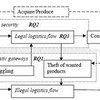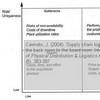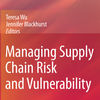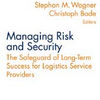 Close calls and near misses are not unusual in the business world, but how do companies deal with them? Published in 1999, the Harvard Business Review on Crisis Management
Close calls and near misses are not unusual in the business world, but how do companies deal with them? Published in 1999, the Harvard Business Review on Crisis Management is my third post on the Harvard Business Review Paperback Series, not that I intend to review all 73 of them. But this book reflects much of what is on my mind these days. I’ve had this book on my bookshelf for some time now, and I was planning on a review later this month, but the news on SAAB’s demise compelled me to move up my review in my posting schedule. The closure of SAAB is a major crisis by all standards, and is a fitting reminder that this 10-year old book will never go out of date. Why and how do some companies survive, and some not? This book sheds some light on this.
Thought leaders and rising stars
As with all books in the Harvard Business Review Paperback Series, this one too is written by the preeminent thinkers and the emerging experts of the field. There are eight separate essays or chapters, each devoted to a certain aspect of crisis management.
Each chapter is equipped with an executive summary that can be read before the article, to see if this is something worth spending time on, or after the article, for summary and refreshing one’s memory. Excellent. There’s also a very brief bio of the contributors (which helped me in locating my links below) and a keyword index.
As always, I did my best in trying to find a personal or company website belonging to each of the authors, but I didn’t find many, mostly because this book is almost 10 years old, so if any of my readers want to help locate the rest, or if my links are wrong, particularly if you are the author who is mentioned, please contact me).
Those who lived to tell
This is a book with three stories told by those who lived to tell how they survived a major crisis, and it is a book with three fictional crisis cases, where different management consultants weigh in on the options available and it is a book with two articles on strategic advice on how to and how not to manage closes calls and near misses.
One by one
Managing the Crisis You Tried To Prevent by Norman R Augustine is an essay about the six steps or stages of crisis management: 1) Avoiding the crisis, 2) Preparing to Manage the Crisis, 3) Recognizing the Crisis, 4) Containing the Crisis, 5) Resolving the Crisis, 6) Profiting from the Crisis. All with examples of companies that did well, and companies that did not so well, as Ericsson and Nokia are prime examples of.
When An Executive Defects by Anurag Sharma and Idalene F Kesner is fictional case study about how companies should address the “defection” of an executive going to a competitor. Here, five experts of communication offer advice on how communicate with the media, with the employees and customers, with the “culprit”, and how to protect intellectual property and manage knowlegde that is disappearing out the front door with a no-disclosure agreement.
A Strategic Approach to Managing Product Recalls by N Craig Smith, Robert J Thomas, and John A Quelch is a step-by-step guideline for product recalls, looking at the time before, during and after a product recall and what implications this should have on 1) Policy and Planning, 2) Product Development, 3) Communications 4) Logistics and 5) Information Systems. Again, with excellent real-life examples that will make you think. Here’s a recent reminder of things that can go wrong: Mr. Squiggles, as reported by Regester Larkin.
Right Away and All at Once: How We Saved Continental by Greg Brenneman is a fascinating account by the then COO of Continental Airlines, describing first-hand the five lessons of how he and the new team at Continental transformed the company: 1) File your flight plan and track your progress: find your action plan, stick to it, and monitor your performance. 2) Clean your house: The people who brought the business in to the crisis are NOT the ones who are likely to bring the business out of the crisis, so sweep out the old. It’s brutal, but it works. 3) Think “money in” not “money out”: Cutting costs lessens money out, but it never brings money in. Find ways to generate revenue, do not seeks ways to minimize losses. 4) Ask the customer the right questions: What is it that they would actually be willing to pay for to use your services rather than your competitors’. 5) Let the inmates run the asylum: Engaging your employees in making work fun does not run counter to strong, firm and directing leadership. Treat their ideas and suggestions with respect.
Media Policy – What Media Policy? by by Sandi Sonnenfield is another fictional case study. Here a charity donation goes terribly wrong, as it turns out that the initial benefactor in turn has supported an organization that now has resorted to violence to make a political statement. How far does corporate social responsibility run and where do you stop being responsible for someone’s actions, and most of all, how do you handle the media who will love sticking this incident on your brand reputation, not for good, but for worse. Again, five media experts weigh in on what steps to take and discuss the components of an effective media policy. Sidenote: For a list of current “OOPS”es in Public Relations, Fineman PR’s list of annual PR blunders is a good read.
After the Layoffs, What’s Next? by Suzy Wetlaufer is yet again a fictional case, a complex story of mismanaged downsizing and of a defecting manager taking with him a seizable number of employees, a sudden unannounced closure of a major store, and the rest wondering what or who is next, perhaps a poignant but otherwise unrelated reminder of the SAAB demise. Nonetheless, the essence of this case is how does a company revive morale and survive under such circumstances? On a sidenote, Susan Wetlaufer has had her own share of crisis management to deal with. She is now Susan Welch, and in early 2002, she was forced to resign from the Harvard Business Review after admitting to an affair with the then-married Jack Welch, the former chief executive officer of General Electric, while preparing an interview with him for the magazine.
Leadership When There Is No One To Ask: An Interview with Eni’s Franco Bernabè by Linda Hill and Suzy Wetlaufer tells the story of how Eni, an energy-focussed industry group in 1992 became a prime target during Italy’s “Mani Pulite” or “Clean hands” anti corruption investigation in the midst of a structural re-organization. How do you leas a company through extreme internal resistance to change and extreme external scrutiny. Bernabé answer was to seek consultation, but to lead and decide in solitude.
Lincoln Electric’s Harsh Lessons from International Expansion by Donald F Hastings is an account of how Lincoln Electric failed miserably when they tried to expand their business in Europe and Asia, not realizing perhaps that the American way of doing business can not and will not work in Europe or Asia. The business culture is simply too different, and labor laws and regulations are often counterproductive to incentive systems aimed at improving performance. It was a bitter lesson learned, but a necessary lesson, without which the company would not be as strong as it is today.
Conclusion
The Harvard Business Review Paperback Series are not written for us academics and researchers, but for the professional manager seeking executive perspectives and solutions. That does not make this book less valuable; as a researcher it is always interesting to know what the industry is concerned with in order to focus my research accordingly. The best essay, in my opinion, is Greg Brenneman’s account of his time at Continental airlines, along with Norman Augustine’s strategic advice and the product recall issues. The fictional cases are interesting per se, but reading more or less the same advice five times by five different experts makes these essays a less capturing read. Nonetheless, I certainly know more about the inner workings and real challenges of crisis management than I did before, and thus, can apply it to the case studies and surveys I will conduct in my research.
Reference
Harvard Business Review (1999). Crisis Management. Boston: Harvard Business Press.
amazon
- Buy this book: HBR on Crisis Management
Related
- husdal.com: SAAB is no more…
- husdal.com: Book Review: Single Point of Failure
- husdal.com: Book Review: The Business Continuity Handbook












